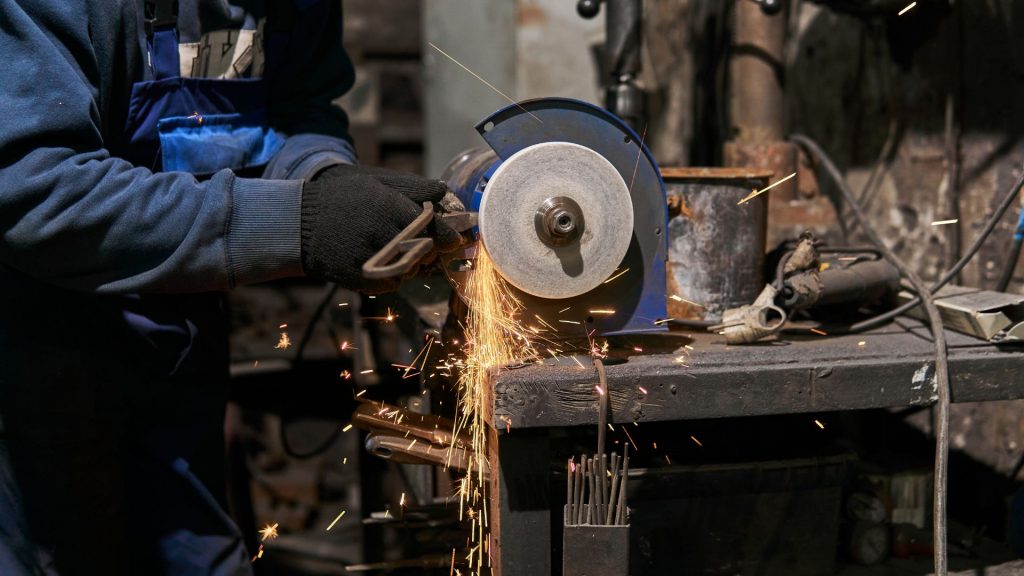
If you’ve ever worked with or seen someone use an abrasive wheel, it won’t come as a surprise to learn that they can cause accidents.
They’re pretty sharp and/or very dangerous.
According to the Health and Safety Executive, there are around 5,000 injuries recorded each year by angle grinders alone.
That’s why anyone operating an abrasive wheel must have had training in order to use them safely.
In this blog, we’ll look at some of the potential dangers that using abrasive wheels can create, as well as some of the top safety checks every workplace should undertake.
What Is An Abrasive Wheel?
Let’s start at the beginning: what are abrasive wheels?
Put simply, they are revolving wheels designed for cutting and grinding hard materials such as metal and concrete.
They are made of abrasive particles stuck together with various substances.
Other terms used to describe them include ‘grinding’ or ‘cutting’ wheels.
Abrasive Wheels can be fitted to various types of mechanical apparatus and handheld machines.
What Are The Dangers Of Abrasive Wheels?
Because of their ability to cut and grind such hard materials, it should perhaps come as no surprise that there are many dangers to operating abrasive wheels.
Their sharp edges can cause devastating (potentially fatal) injuries.
Therefore, anyone who uses an abrasive wheel can be exposed to several risks, including:
- Eye injuries caused by flying metallic and abrasive particles.
- Dust and fume inhalation from dry grinding
- Hand-arm vibration syndrome from prolonged use
- Hearing loss
Causes of abrasive wheel injuries
So we have looked at the potential injuries that abrasive wheels can cause, but how can these injuries happen?
Wheel contact
Abrasive wheels rotate at speed. Subsequent friction can therefore be very dangerous.
Handheld tools like angle grinders can pose a particular risk of injury if there’s any contact between the wheel and flesh.
Wheels breaking
As mentioned above, abrasive wheels turn at speed.
If one was to break while in use, fragments could be ejected at speeds of up to 100 miles per hour.
Drawing in
Anything that comes into contact with the abrasive wheel can get drawn in. This can obviously include the operator’s clothing which could easily result in serious injury.
Unfortunately, many accidents happen with abrasive wheels, most of which are due to wheel contact or wheel breakage. Still, there are design, manufacturing and testing regulations to keep this likelihood down. It’s also essential for users to inspect abrasive wheels before using them and whilst using them.
Abrasive Wheels Regulations
Within any regulated industry, the safety of workers and employees is paramount.
Abrasive wheels are fantastic tools, but their very structure can make them lethal, especially if used by untrained professionals.
The Provision and Use of Work Equipment Regulations Act 1998 (PUWER) looks after abrasive wheel regulations.
It ensures that the equipment:
- Is only used by trained and competent people
- Is regularly inspected by trained and competent people
- Undergoes regular safety maintenance
These regulations apply to all UK businesses, including employers, self-employed people and supervisors.
Abrasive Wheel Training
As part of the PUWER regulations, anyone paid to use an abrasive wheel must have previously undergone specific training.
At Sussex Transport, we provide training programmes that comply with these regulations, ensuring successful students are competent and have the necessary training certificates.
Our courses cover the following:
- Health and safety legislation covering abrasive wheels in the workplace
- Type of abrasive wheels
- How abrasive wheels are made
- Abrasive wheel markings
- Wheel and machine inspections
- Safe mounting of abrasive wheels
- Safe use of abrasive wheels in the workplace
Candidates are required to successfully complete a theory and practical assessment over the one- or two-day course (depending on class size).
Summary
Abrasive wheel training is legally required to ensure the safety of anyone who uses tools such as angle grinders, bench-mounted grinders and cut-off saws in the workplace.
The tools – while efficient and proficient – can be potentially lethal, so it is imperative to ensure regular checks are carried out to ensure they’re in good working order.
Training certificates are necessary to prove competence and qualifications to operate such machinery.
If you would like to find out more information about Sussex Transport’s Abrasive Wheel training course, contact our team today.